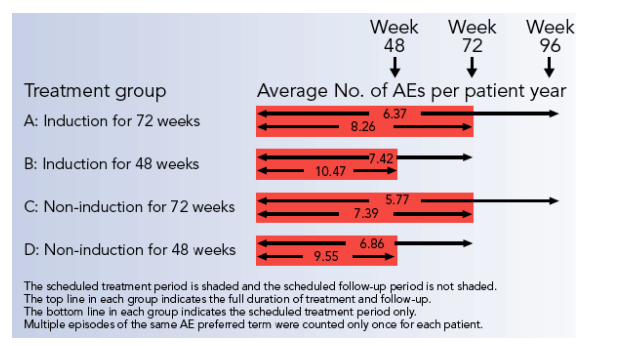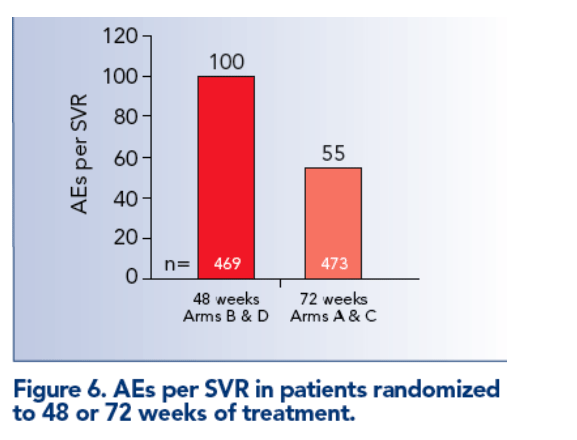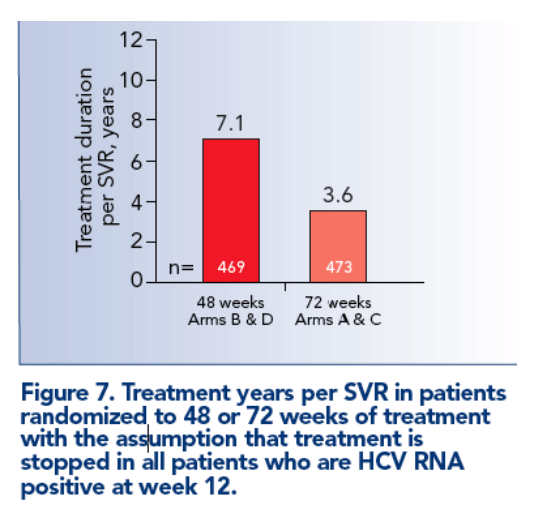 |
 |
 |
| |
A 72-week treatment duration with peginterferon alfa-2a (40KD) (PEGASYS) plus ribavirin (COPEGUS) has a favorable risk:benefit ratio in non-responders to pegylated interferon alfa-2b (12KD) plus ribavirin: findings of the multinational REPEAT study
|
| |
| |
Reported by Jules Levin
AASLD Nov 4 2008 San Francisco, CA
P. Marcellin,1 A. Craxi,2 C.E. Brandao-Mello,3 A.M. Di Bisceglie,4 P. Andreone,5 B. Freilich,6 K.R. Reddy,7 A. Olveira,8 G. Teuber,9 D. Messinger,10 G. Hooper,11 J.A. Thommes,12 D.M. Jensen13
1Service d'Hepatologie and Centre de Recherches Biologiques Bichat Beaujon (Inserm CRB3), H˘pital Beaujon, Clichy, France; 2Divisione Di Gastroenterologia, Instituto Di Clinica Medica Policlinico, Palermo, Italy; 3University of Rio de Janeiro, Rio de Janeiro, Brazil; 4St. Louis University Liver Center, Saint Louis University School
of Medicine, Saint Louis, MO, USA; 5Department of Internal Medicine and Gastroenterology, University of Bologna, Bologna, Italy; 6Liver and Pancreas Institute of Kansas City, Kansas City, MO, USA; 7Division of Gastroenterology, University of Pennsylvania, Philadelphia, PA, USA; 8Hospital La Paz, Madrid, Spain;
9Department of Internal Medicine, J.W. Goethe University Hospital, Frankfurt, Germany; 10IST GmbH, Mannheim, Germany; 11Roche, Welwyn, United Kingdom; 12Roche, Nutley, NJ, USA; 13Center for Liver Diseases, University of Chicago Hospitals, Chicago, IL, USA
CONCLUSIONS
Extending the duration of treatment in REPEAT with peginterferon alfa-2a (40KD) plus ribavirin to 72 weeks produced a significant increase in SVR rates compared with 48 weeks for patients who previously did not respond to pegylated interferon alfa-2b (12KD) plus ribavirin.
Prolonged therapy did not impose a large additional safety burden on these patients, but resulted in the continuation of the same safety burden associated with the 48-week regimen.
Furthermore, a quantitative analysis of the safety burden associated with treatment duration in REPEAT demonstrates that a 72-week treatment duration is associated with a more favorable risk/benefit trade-off and that the risk/benefit is greatest when a 12-week stopping rule is included.
These data demonstrate that 72 weeks of treatment with peginterferon alfa-2a (40KD) plus ribavirin is the preferred regimen for non-responders to previous treatment with the combination of pegylated interferon alfa-2b (12KD) and ribavirin.
Introduction
Improvement in viral eradication rates after the introduction of pegylated interferon has resulted in more widespread use of therapy for chronic hepatitis C. Despite the increases in sustained virologic response (SVR) rates, approximately 50% of genotype 1 patients and 20-30% of genotype 2 or 3 patients are not cured by a first course of therapy;[1-3] thus, there is a large and growing pool of patients who have not responded to treatment with the standard of care and may be eligible for re-treatment.
In certain difficult-to-treat subgroups of treatment-naive individuals, intensification of therapy by increasing the dose of interferon or ribavirin (COPEGUS) or extending the duration of treatment has been shown to enhance efficacy.[4-6] The REPEAT trial was designed specifically to evaluate intensification of therapy in previous non-responders to pegylated interferon alfa-2b (12KD) plus ribavirin.[7]
In REPEAT, 72 weeks of treatment was significantly more effective than 48 weeks of treatment with peginterferon alfa-2a (40KD) (PEGASYS) plus ribavirin in 942 non-responders to pegylated interferon alfa-2b (12KD) plus ribavirin.[7] SVR rates were 16% and 8% in those randomized to 72 and 48 weeks of combination therapy, respectively (odds ratio 2.22; 95% confidence interval: 1.40-3.52, p=0.0006).[7]
The benefit of extended therapy on viral eradication rates is clear; however, prolonging therapy extends the period over which patients are exposed to the risk of adverse events (AEs).
OBJECTIVE
The objective of this retrospective analysis of data from the REPEAT trial
was to estimate the risk:benefit ratio of treating previous non-responders
for 72 weeks compared with 48 weeks by examining AE rates and outcomes for the two treatment durations.
METHODS
Patients
Patients eligible for REPEAT were aged 18 years or older with quantifiable serum HCV RNA (>600 IU/mL; COBAS AMPLICOR HCV MONITOR Test, v2.0, Roche Diagnostics) and histological findings on liver biopsy consistent with the diagnosis of chronic hepatitis C. Patients with cirrhosis were eligible if they had compensated liver disease.
Eligible patients must have received >12 weeks of the combination of pegylated interferon alfa-2b (12KD) (initial dose >1.0 μg/kg/week) and ribavirin (initial dose >800 mg/day) and had detectable serum HCV RNA at every post-baseline assessment, at least one of which was done after week 12. All patients discontinued the previous course of therapy >12 weeks before enrollment in REPEAT.
Treatment
Patients were randomized to subcutaneous peginterferon alfa-2a (40KD) at a dosage of 360 μg/week for 12 weeks and then 180 μg/week to complete 72 weeks (Arm A) or 48 weeks (Arm B), or 180 μg/week for 72 weeks (Arm C) or 48 weeks (Arm D) (Figure 1).
All patients received oral ribavirin at a dosage of 1000 mg/day (body weight <75 kg) or 1200 mg/day (body weight >75 kg) throughout treatment.

Outcomes
The primary efficacy outcome in the REPEAT trial was SVR, defined as undetectable serum HCV RNA (<50 IU/mL by qualitative PCR) at the end of the 24-week untreated follow-up period (i.e. study week 72 in Arms B and D; study week 96 in Arms A and C). Although the study met its primary endpoint (the SVR rate in Arm A was significantly higher than in Arm D), protocol-defined secondary and subgroup analyses identified treatment duration as the strongest predictor for SVR, with little if any impact of induction dosing on SVR. Because SVR rates were low overall and the 72-week treatment duration was associated with the highest probability of achieving an SVR, a precise analysis of treatment burden was undertaken.
AE data were documented during the trial, including the date of onset, severity and duration.
A quantification of risk/benefit associated with both treatment durations was undertaken by calculating the AE incidence per SVR and the number of treatment days with AEs per SVR, and by evaluating the treatment years per SVR. If the same AE occurred on more than one occasion in the same patient, it was counted only once. The number of treatment days with AEs includes each treatment day an AE was present, regardless of the number of AEs present in the patient on the day. AEs with an onset up to 7 days after treatment discontinuation were included as on-treatment AEs.
Because of the high negative predictive value of a 12-week stopping rule in REPEAT (94% in patients randomized to 72 weeks of treatment) this analysis was also done by assuming that treatment was stopped in all patients who were HCV RNA positive at week 12.
RESULTS
The total number of on-treatment AEs and cumulative number of treatment days with AEs (or serious AEs) were slightly higher in patients randomized to 72 weeks than in patients randomized to 48 weeks of treatment (Table 1).
The average number of AEs per patient on each treatment day is shown in Figure 2. The peak burden experienced in both the 48-week and 72-week treatment groups was slightly more than four AEs per patient per treatment day and remained constant after week 48 in the 72-week treatment group. The average number of serious AEs/treatment day was close to zero (i.e. for every 100 patients on treatment there were <2 serious AEs/treatment day).


The incidence of AEs per treatment year was lower in patients treated for 72 than for 48 weeks (Figure 4).
The risk/benefit associated with 72 weeks of treatment was more favorable than that associated with 48 weeks of treatment when the cumulative treatment duration required to achieve an SVR (Figure 5) or the number of AEs per SVR (Figure 6) was taken into consideration.
When the analysis was performed with the assumption that a 12-week stopping rule would be used (i.e. that treatment is stopped in all patients who are HCV RNA positive at week 12) the risk/benefit of 72 weeks of treatment was increased further (Figure 7).



|
| |
|
 |
 |
|
|